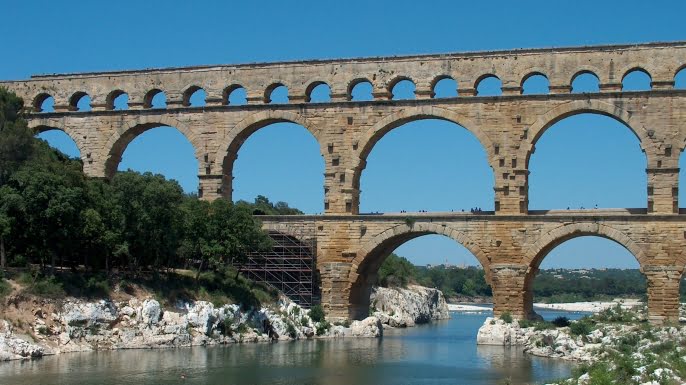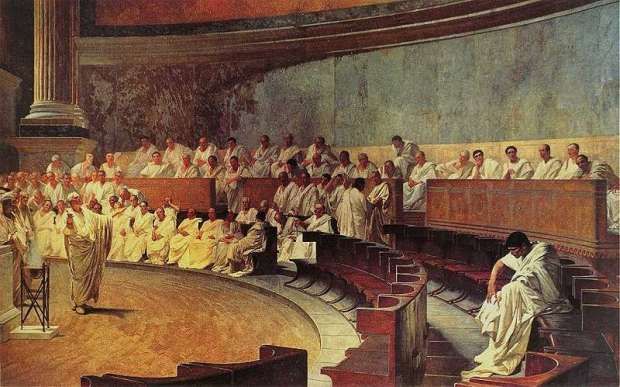The Western Roman Empire fell over 1,500 years ago, but its heritage and achievements are valued to this day. The Romans were great builders and inventors. What made Rome such great power?
I. Aqueducts
Ancient Romans could count on many amenities during the day, including public toilets, underground sewers, fountains, and thermal baths. However, none of these water structures could exist and function without the Roman aqueduct. Aqueducts were known before (primitive canals for irrigation purposes already existed in Egypt or Assyria), but it was only the Romans who popularized them, adding even more momentum. The first Roman aqueduct was Aqua Appia erected in 312 BCE, mostly underground. It supplied water from the Albanian Hills more than 16 km away to Rome.
But what was the secret of the aqueduct? The Romans were so ingenious that they only used gravity to transport large amounts of water from distant reservoirs. The success of Roman aqueducts was in the technique of building arcades, which allowed the Romans to throw water pipes over the valleys and uneven terrain, significantly shortening the length of their route. The decline in Roman aqueducts was only a few dozen cm per kilometre.
The longest aqueducts transported water over a distance of approx. 96 km. Their construction was so durable that you can admire them to this day, and some of them are still in use – for example, the famous Di Trevi Fountain is supplied by the restored Aqua Virgo – one of 11 Roman aqueducts.
II. Cement
Lots of Roman constructions like the Pantheon, Colosseum or The Forum Romanum would not exist today if it were not for the extremely strong Roman cement and concrete. The ancient Romans used concrete more than 2,100 years ago and spread it throughout the Mediterranean.
Roman cement was certainly weaker than its modern counterpart, but for those times it was extremely durable. The Romans made cement from a mixture of lime and volcanic rock. The species used for underwater structures consisted of lime and volcanic ash, and the mortar obtained in this way was mixed with the tuff and placed in wooden molds. There was an immediate hot reaction when immersed in water. The lime was hydrated and reacted with the ash. Extremely resistant cement was created, thanks to which the Romans were the first to achieve the mastery of building durable arches.
III. Newspapers
The Romans are known for taking into account and describing all military, legal or clerical aspects in official letters, available to the public.
The first and only newspaper of the ancient world was founded by Julius Caesar in 59 BCE (there are reports that it already existed around 131 BCE). It was called Acta Diurna, meaning “Events of the Day” and unfortunately, no copy has survived; we also do not know the amount of its circulation.
The information was wildly similar to what we can read in modern newspapers. The concerning news about Senate deliberations, people’s assemblies, lawsuits, executions, maritime and military news, and even weddings, births and obituaries. In the “sports” section, the Romans could learn about the results of gladiator fights or chariot racing in Circus Maximus. The newspaper was published until CE 330 (the capital was moved to Constantinople), i.e. for nearly 400 years.
There was also reportedly an Acta Senatus that documented the proceedings of the senate. Until 59 BCE, it was inaccessible to the public. It was only Caesar who decided to make it public during his first consulate.
IV. Prosperity
The first social programs and subsidizing food, education and expenses appeared in ancient Rome. Such programs were introduced as early as 122 BCE, when the tribune of the people, Gaius Gracchus, pushed the Lex frumentaria – a law allowing the Romans to buy grain at low prices. This early form of prosperity continued during the reign of Trajan (CE 98-117). During the reign of this emperor, the so-called alimenta, provide food, clothing, and the upbringing of orphans and poor children.
There is also a view that the famous tesserae were tokens given at public events that entitled them to receive certain goods at the expense of the state.
V. Books
Throughout most of human history, literature has taken the form of bulky clay tablets and scrolls. The Romans improved the recording of more information by creating codes-related pages that together formed the early version of the book.
The early codices consisted of a number of related wax tablets, which in time gave way to parchment made from animal skin. Codes, however, were not adopted until the 1st century CE. The early Christians were the first to use the new technology, mainly to write down their religious truths.
VI. Roads
At its peak – at the beginning of the 2nd century CE – the Roman Empire was over 4 million square kilometres. In order to efficiently manage such a large area, it was necessary to have a good combination of centres and provinces. To this end, the Romans built one of the best road systems that ever existed.
The first roads were built as early as the 4th century BCE and were modelled on those built by Etruscan. The paved road was built using a combination of sand, gravel and bricks made of granite or hardened volcanic lava. Roman engineers paved roads of the shortest possible length, and therefore mainly in a straight line. The Romans were also aware of the need to drain rainwater that had accumulated in special ditches by the road.
By 200 CE, the Romans had created a road network of approximately 80,000 km. It cannot be denied that the roads were also important from a military point of view. Roman conquests and war campaigns were possible especially thanks to the perfect Roman beaten roads.
It is also worth mentioning that alongside the roads, there were milestones, the purpose of which was, of course, to inform travellers about the distance to specific places. There were also military patrols.
VII. Roman arches
Arches have been in practice for 4,000 years, but the ancient Romans were the first to use them effectively in architecture, using them to construct powerful structures: bridges, monuments. The Romans were able to use arches to build, for example, the impressive Colosseum.
The Romans introduced a modification to the structure of the arches, including flattening them and creating successive segments of the arches overlapping each other. Thus, Roman architecture gained its own style.
VIII. Julian Calendar
The modern Gregorian calendar is modelled on its Roman counterpart, more than 2,000 years old. Early Roman calendars were taken from Greece, where the cycle of the moon was observed. In 46 BCE, Julius Caesar with the help of his astronomer Sosigenes of Alexandria introduced another reform of the Roman calendar. Sozyges calculated that each year is made up of 365.25 days. He specified the number of days for each month and made February a leap year every four years. The change, however, was not to add one day to February, as is done today, but to repeat the same day. So every four years, every Roman lived the same day twice. It was established on February 24.
The Julian calendar was in force in Europe until 1582, when the Gregorian calendar was introduced.
IX. Roman law
Subpoena, habeas corpus, pro bono, affidavit – these are legal terms that were taken from the Roman legal system and which dominated Western Europe. The origins of Roman law go back to the Laws of the Twelve Tables, i.e. 451-449 BCE
This document contained written customary laws that significantly limited the power and activities of the patricians. These rights were published on twelve bronze plaques (leges duodecim tabularum) and posted on public display at Forum Romanum to be known to all citizens.
X. Surgery
Due to the lifestyle, constant wars, battles and conquests, dressing the wounded was almost the order of the day with the Romans. It was the ancient Romans who invented many surgical instruments and began to perform caesarean sections. Roman medics accompanied the legions during their numerous war campaigns. During the Octavian Augustus (27 BCE – 14 CE) a special medical corps was established that operated alongside the legion.
The legions also had their own well-equipped hospitals. In one of them, located near the Germanic border, archaeologists discovered hearths in which surgical instruments were sterilized. The most complete picture of the work of Roman surgeons is given by the treatise by Cornelius Celsus on medical procedures. According to the advice of the ancient physician, the surgeon should be young, have a strong, efficient and steady hand, and excellent eyesight, and never give up. He must sympathize with his patients, but at the same time keep a distance that will allow him to develop resistance to moans. Otherwise, he could be pressured to work faster and therefore less precise or not cut deep enough.
Roman doctors also knew anaesthetics. The herbs that were particularly recommended were: black hen and opium poppy.
















